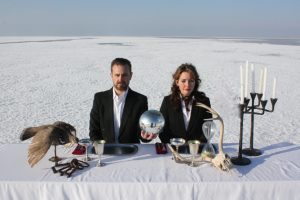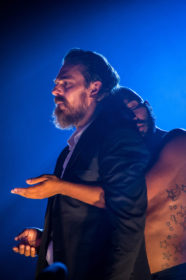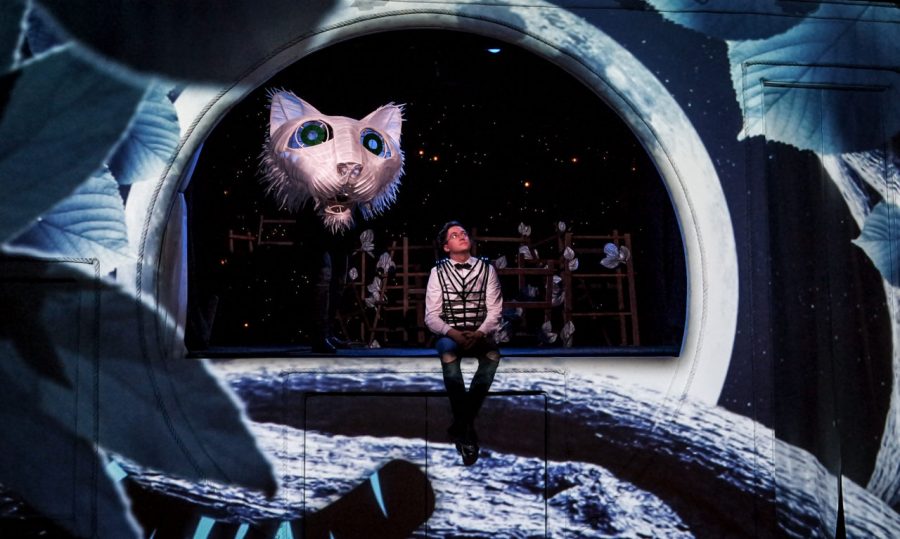Theatrical laboratory Flying Bobcat was born out of happenstance. Its artistic directors met by chance at the Leonardo Museum in downtown Salt Lake City.
Robert Scott Smith is one of the founders and co-artistic directors of Flying Bobcat. He is also a professor at the University of Utah in the Actor Training program. He recently directed an all-female production of “Hamlet” at the U and prior to that was the tiger/narrator in “Climbing with Tigers.” Other recent credits include “Saturday’s Voyeur” at Salt Lake Acting Company. He received his MFA at the Old Globe Theatre Actor Training Program at the University of San Diego and his BFA from the U, also in the Actor Training Program.
Alexandra Harbold is the other founder and co-artistic director of Flying Bobcat. She co-created and directed “Senses 5,” “Love” and “Mind Over Matter” for the Leonardo. She also directed several shows at Salt Lake Acting company while serving as their artistic and literary associate. She has worked with many local companies including Pioneer Memorial Theater, Pygmalion and Pinnacle acting company. Most recently, she directed “Self Defense” at the U. She has her master’s degree from the University of London Goldsmiths College and a BA from Middleburg College. She is certified in Stanislavsky and Viewpoints training from Skidmore College and has trained with the British American Drama Academy, Oxford at Balliol College.
These two founders drew together to create pieces for a series of pop-up shows at the Leonardo. The fusion of art, science and technology in these shows drew Smith and Harbold in a new creative direction — soon finding themselves directing pieces such as “Mind over Matter” by Caitlin Blue, where they projected images of the human body onto themselves.
Smith said he always thought about creating new work while living and working in New York City as an actor. Once he started working at the Leonardo, he realized how much he enjoyed the pop-up series and devised theater as his medium.

According to Smith, his style is based around “a collaboration of different artists across different disciplines creating new work.” In his view, “artists” and “disciplines” could be anything followed by a spark of inspiration: “Everything depends on where the creative spark lies.”
For Smith and Harbold, their spark resided in founding their own theater company — Flying Bobcat. This company is unique in more ways than its creation. It isn’t merely focused on choosing shows to please an audience or to get funds. Its artists build shows off of what inspires them. Smith explained he and Harbold aren’t thinking about a “target” or “model” but “the work itself and who [they] want to see the work.”
Flying Bobcat is by no means traditional. In “Feast,” the two combined dance and theater — Smith even shaved his beard onstage in a one-night performance. “Climbing with Tigers” was an entirely different show all together. Inspired by the incorporation of animation, Flying Bobcat paired with playwright Troy Deutsch to tell a story written by Dallas Graham and Nathan Glad. The story is about a little bird who is limited in his sickness, much like author Glad who was born with osteogenesis imperfecta (OI), but is healed by a magical silver tiger. The show, sponsored by Salt Lake Acting Company, brought together two actors, projection animation, a beautiful tiger’s head mask and the voices of local artists to tell Glad’s story.
 Flying Bobcat is, as Smith said, a “theatrical laboratory concocting new work and… everything just comes out of wherever we are in our central theme.” The biggest challenge of this company is not money, choosing shows or even deciding who to work with. “When you create work, you are already willing to work through things and problem-solve,” he said. With an endless amount of opportunities for shows and new avenues to follow, Smith and Harbold found their biggest challenge was creating work and following through to put it out there.
Flying Bobcat is, as Smith said, a “theatrical laboratory concocting new work and… everything just comes out of wherever we are in our central theme.” The biggest challenge of this company is not money, choosing shows or even deciding who to work with. “When you create work, you are already willing to work through things and problem-solve,” he said. With an endless amount of opportunities for shows and new avenues to follow, Smith and Harbold found their biggest challenge was creating work and following through to put it out there.
However, just working is not enough for this inventive new company. “Our biggest concern is the quality of the work,” Smith said, which results in shows that take anywhere from three weeks to a year to produce. “Artists are already willing to think outside the box.” This innovative thinking is what allows the company to work with so many unforeseen challenges. “We have to figure out our own way of shaping, as a trajectory, what we want,” he said.
Smith is adamant that Flying Bobcat is “not reinventing the wheel.” He and Harbold are storytellers who simply tell stories in their own unique way. Smith talked about his experience teaching and how his classroom is a collaborative space — a echoed in Flying Bobcat’s goal in expanding its collaborative network nationally and internationally and to do more work in more locations. Smith said he would like to collaborate “beyond what’s comfortable” or “in close proximity.”
Each piece Smith and Harbold presents is unique and no two pieces are the same. The directors seem to enjoy the experience of living in the unknown and waiting to see what comes next. According to Robert, this is because “not only do [they] want to create work [they] want to learn how to do better work.” Look out for their next piece. It could be in a few weeks or a few months but whenever it does come, it is sure to be good.
m.slack@dailyutahchronicle.com


